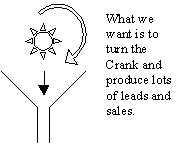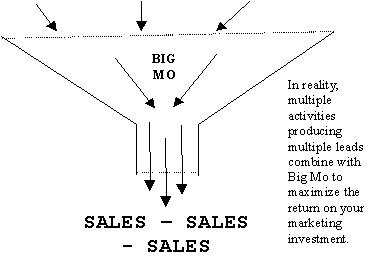![]()
![]()
Marketing Survival Newsletter - Big Mo - Momemtum in Marketing
In the past few weeks Third Party International has been offering a free Marketing Allocation Analysis. This idea came about from watching financial investment advisors talk about stock investment portfolios. Over the past 30 years, as I have invested in the stock market I have been taught how important it is to properly allocate one's investments so as to maximize return-on-investment, while minimizing risk. A few months ago, while doing a personal financial review, it occurred to me that over the past 15 years we have been teaching the same concept about marketing. When you make an investment in marketing, you hope to reap a return (usually measured in sales). One of the most common problems we encounter with clients is that their marketing allocation is usually off. As a result, they invest money in specific activities, and are dissatisfied with their return. This TPI Software Survival Newsletter addresses this concept of Marketing Allocation, and gives some guidelines for doing your own Marketing Allocation Analysis.
First, it is important to understand the concept of Marketing Allocation. While improper financial investment allocation exposes the investor to higher risk, improper marketing allocation dooms the investor to poor results.
 Let me explain. We think of marketing as a process in which we take some action, (ad, mailing, show, etc.), receive the responses, and make the sales. We turn the crank one turn, the leads fall through the funnel below, and we reap the rewards. Each turn produces a certain number of leads, so each activity creates a certain number of sales.
Let me explain. We think of marketing as a process in which we take some action, (ad, mailing, show, etc.), receive the responses, and make the sales. We turn the crank one turn, the leads fall through the funnel below, and we reap the rewards. Each turn produces a certain number of leads, so each activity creates a certain number of sales.
The problem is that in marketing we have a factor called BIG MO. Big Mo is momentum, and the more marketing you do, the bigger Big Mo becomes. So, if you do one ad, Big Mo doesnít exist. If you do 3 ads, Big Mo is a baby, if you do 12 ads, Big Mo is growing up, and if you do 12 ads, 3 press releases, two applications stories, attend 2 shows, and have a great Internet presence Ė Big Mo is starting to look like a 10,000 pound gorilla.
My point is that by combining several activities in a well organized marketing plan, you will not only receive results from each activity, but you will also capitalize on the cross-over affect (Big Mo), generated by each concurrent and successive activity. You will build momentum. Surprisingly, Big Mo will actually generate more overall leads than the sum total of each individual activity. A case where the whole is greater than the sum of its parts.
This defines our first few principals of proper marketing allocation Ė multiple step, consistent, and multi-faceted marketing. It is the use of several marketing activities, done concurrently in 3 or more occurrences each, and done consistently over a period of time.
For example, letís say you run one ad in a magazine. Chances are the results from one ad will be minimal. If you run 3 ads in the same publication over a 6 month period, you give the potential customer the opportunity see your ad multiple times, you increase your chance of being in the right place at the right time (having them see it when they need it), and you increase your exposure because more people will notice the ad. Will you get better results? Logic and experience say yes.
Now letís expand on this concept a bit. Letís say you run the ads, and you also do a press release that gets published in 3 publications. What happens now? First, more people see your product name, so you get more leads. But, you also have the same people seeing your ad, and also seeing your PR in other publications. Again, you increase your chance of being in the right place at the right time, and you reinforce your image as a stable, established product. Will you get better results? What do you think? Correctamundo Ė YES!
Now letís take it one step further. Letís say over a 12 month period you run ads every other month in alternating magazines; you do 4 press releases, you have two application articles published, you do several email campaigns, and you have a hot web site on-line that potential customers can find. Will you get better results? What do you think? By George, I think youíve got it.
That picture I inserted above will now change to look like this:




Consistency
The previous paragraphs discussion the elements of multi-stepped and multi-faceted marketing, whatís left is consistency. But, what difference does it make if you run one ad three times, or one ad every 6 months? The difference is that people, including you and me, have short memories for new ideas. If you are trying to introduce a new product or concept, you need to be in front of a prospective customer at least three times in a short enough period of time to prevent them from completely forgetting about you. Otherwise, each time you run an ad you are essentially starting from the beginning.
An analogy might be a rocket taking off from a pad. If you light the burners and keep them firing for the required time, the rocket reaches orbit. On the other hand, if you light the burners, run them for 5 seconds and then turn them off for 5 seconds, the rocket lifts off the pad, and then settles down on the pad again. If you do this 100,000 times, you will still not get off of the launching pad. This is what happens when you do one marketing activity (such as one ad), and wait 3 or more months to do another activity (ad). Youíre still on the launching pad with regards to creating awareness, and demand for your product. We call this start-stop marketing, and it is the second most common mistake after single focus marketing.
This applies to existing products as well. How many organizations do you know that own their market, yet still advertise and promote their product as if it were new? Probably quite a few. Successful companies know that marketing keeps them in front of their customer, and market leaders spend a lot of effort staying that way. Of course most of us are not Diemler-Benz, or Coca-Cola, but regardless of your size, product, or market position, these solid marketing principals will work for you.
So, the first step to a Marketing Allocation Analysis is review your activities and look at them from the perspective of a multiple step, consistent, multi-faceted marketing plan. If you find start-stop marketing, or single focus marketing efforts in your activities, make changes. Triple up on your marketing activities (3 times each), make sure you have multiple marketing activities going concurrently, and never allow gaps of 2 months or more in your marketing plan. These concepts alone will improve the effectiveness of most marketing plans.
This is just the beginning. A thorough Marketing Allocation Analysis will include comparing your market demographic with your marketing activities, ensuring your marketing tools are reaching your prospective customer, and evaluating the cost effectiveness of each activity. You should also do a thorough review of past activities to evaluate their effectiveness, and review your overall company or product positioning to insure you are communicating the most effective message to your potential customer. But that is much more than this newsletter can cover. For now, I hope this introduction is of help. If you would like further assistance, I am happy to offer my services in a free 30 minute consultation to share more ideas.
~Nick Vasilieff
This newsletter was written by Nickolai N. Vasilieff; freelance writer and marketing consultant specializing in high technology industries.
For more information see www.nvasilieff.com. To contact Nick with questions or feedback, call 503-267-6339 or email vasilieff@mac.com.
Return to© Copyright 2009 Third Party International. All Rights Reserved.